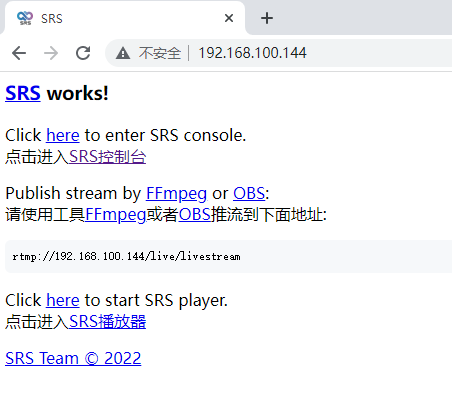SRS搭建小型高可用集群服务
方案
因为方案考虑到后期客户不会给您太多机器,因此部署SRS搭建小型高可用集群服务也需要6台吧,肯定也有不完美的地方

我用了6台服务器,都是1H2G的配置进行验证(都关闭防火墙)
源站:
192.168.100.41-42
边缘:
192.168.100.45-46
边缘服务器后期是可以无限添加的,只要有资源即可
Ha-nginx:
192.168.100.43-44
参考:https://mp.weixin.qq.com/s/pd9YQS0WR3hSuHybkm1F7Q (最佳实践:如何扩展你的SRS并发能力)
Haproxy的安装和配置
haproxy是安装在192.168.100.43上的,用于负载源站。
系统使用的是Centos 7.6,因为是实验性Haproxy,因为直接Yum安装了:yum -y install haproxy
修改配置文件
/etc/haproxy/haproxy.cfg
配置内容如下(其实就是注释掉了我不需要的,主配置没动,添加了源站转发):
#---------------------------------------------------------------------
# Example configuration for a possible web application. See the
# full configuration options online.
#
# http://haproxy.1wt.eu/download/1.4/doc/configuration.txt
#
#---------------------------------------------------------------------
#---------------------------------------------------------------------
# Global settings
#---------------------------------------------------------------------
global
# to have these messages end up in /var/log/haproxy.log you will
# need to:
#
# 1) configure syslog to accept network log events. This is done
# by adding the '-r' option to the SYSLOGD_OPTIONS in
# /etc/sysconfig/syslog
#
# 2) configure local2 events to go to the /var/log/haproxy.log
# file. A line like the following can be added to
# /etc/sysconfig/syslog
#
# local2.* /var/log/haproxy.log
#
log 127.0.0.1 local2
chroot /var/lib/haproxy
pidfile /var/run/haproxy.pid
maxconn 4000
user haproxy
group haproxy
daemon
# turn on stats unix socket
stats socket /var/lib/haproxy/stats
#---------------------------------------------------------------------
# common defaults that all the 'listen' and 'backend' sections will
# use if not designated in their block
#---------------------------------------------------------------------
defaults
mode tcp
log global
option tcplog
option dontlognull
option http-server-close
option forwardfor except 127.0.0.0/8
option redispatch
retries 3
timeout http-request 10s
timeout queue 1m
timeout connect 10s
timeout client 1m
timeout server 1m
timeout http-keep-alive 10s
timeout check 10s
maxconn 3000
#---------------------------------------------------------------------
# main frontend which proxys to the backends
#---------------------------------------------------------------------
#frontend main *:5000
# acl url_static path_beg -i /static /images /javascript /stylesheets
# acl url_static path_end -i .jpg .gif .png .css .js
#
# use_backend static if url_static
# default_backend app
#---------------------------------------------------------------------
# static backend for serving up images, stylesheets and such
#---------------------------------------------------------------------
#backend static
# balance roundrobin
# server static 127.0.0.1:4331 check
#---------------------------------------------------------------------
# round robin balancing between the various backends
#---------------------------------------------------------------------
#backend app
# balance roundrobin
# server app1 127.0.0.1:5001 check
# server app2 127.0.0.1:5002 check
# server app3 127.0.0.1:5003 check
# server app4 127.0.0.1:5004 check
listen srs-cluster
bind *:1935
mode tcp
balance roundrobin
server master1 192.168.100.141:1935
server master2 192.168.100.142:1935
验证配置文件
haproxy -f /etc/haproxy/haproxy.cfg -c
启动haproxy
systemctl restart haproxy
SRS 源站安装与配置
SRS 源站集群参考官网:https://github.com/ossrs/srs/wiki/v4_CN_OriginCluster
SRS安装参考:
SRS源站1(192.168.100.41)的配置:
说明下,默认的启动配置应该是srs.conf。我做了备份,修改了这个文件。
# main config for srs.
# @see full.conf for detail config.
#监听的流端口
listen 1935;
#最大连接数
max_connections 1000;
srs_log_tank file;
srs_log_file ./objs/srs.log;
daemon on;
http_api {
enabled on;
listen 1985;
}
http_server {
enabled on;
listen 8080;
dir ./objs/nginx/html;
}
rtc_server {
enabled on;
listen 8000; # UDP port
# @see https://github.com/ossrs/srs/wiki/v4_CN_WebRTC#config-candidate
candidate $CANDIDATE;
}
vhost __defaultVhost__ {
hls {
enabled on;
hls_fragment 10;
hls_window 60;
hls_path ./objs/nginx/html;
hls_m3u8_file [app]/[stream].m3u8;
hls_ts_file [app]/[stream]-[seq].ts;
}
http_remux {
enabled on;
mount [vhost]/[app]/[stream].flv;
}
# rtc {
# enabled on;
# # @see https://github.com/ossrs/srs/wiki/v4_CN_WebRTC#rtmp-to-rtc
# rtmp_to_rtc off;
# # @see https://github.com/ossrs/srs/wiki/v4_CN_WebRTC#rtc-to-rtmp
# rtc_to_rtmp off;
# }
cluster {
#集群的模式,对于源站集群,值应该是local。
mode local;
#是否开启源站集群
origin_cluster on;
#源站集群中的其他源站的HTTP API地址
coworkers 192.168.100.142:1985;
}
}
启动服务:
systemcty restart srs
SRS源站2(192.168.100.142)的配置:
# main config for srs.
# @see full.conf for detail config.
#监听的流端口
listen 1935;
#最大连接数
max_connections 1000;
srs_log_tank file;
srs_log_file ./objs/srs.log;
daemon on;
http_api {
enabled on;
listen 1985;
}
http_server {
enabled on;
listen 8080;
dir ./objs/nginx/html;
}
rtc_server {
enabled on;
listen 8000; # UDP port
# @see https://github.com/ossrs/srs/wiki/v4_CN_WebRTC#config-candidate
candidate $CANDIDATE;
}
vhost __defaultVhost__ {
hls {
enabled on;
hls_fragment 10;
hls_window 60;
hls_path ./objs/nginx/html;
hls_m3u8_file [app]/[stream].m3u8;
hls_ts_file [app]/[stream]-[seq].ts;
}
http_remux {
enabled on;
mount [vhost]/[app]/[stream].flv;
}
# rtc {
# enabled on;
# # @see https://github.com/ossrs/srs/wiki/v4_CN_WebRTC#rtmp-to-rtc
# rtmp_to_rtc off;
# # @see https://github.com/ossrs/srs/wiki/v4_CN_WebRTC#rtc-to-rtmp
# rtc_to_rtmp off;
# }
cluster {
#集群的模式,对于源站集群,值应该是local。
mode local;
#是否开启源站集群
origin_cluster on;
#源站集群中的其他源站的HTTP API地址
coworkers 192.168.100.141:1985;
}
}
启动服务:
systemcty restart srs
两份配置文件差异只在 最后一个 coworkers,写出了自己以外的源站IP即可
测试
使用ffmpeg推流到负载均衡192.168.100.143
#!/bin/sh
for((;;)); do
ffmpeg -re -i /root/test.flv -vcodec copy -acodec copy -f flv -y rtmp://192.168.100.143/live/livestream;
sleep 1;
done
SRS 边缘安装与配置
边缘的配置都是一样的,是通过NG来进行负载的,所以说边缘的配置相对简单,并且是可以无限扩展的
SRS 边缘集群参考:
- Edge Cluster: RTMP: 如何部署RTMP分发集群,譬如CDN支持RTMP分发。
- Edge Cluster: FLV: 如何部署HTTP-FLV分发集群,譬如CDN支持HTTP-FLV分发。
- Edge Cluster: HLS: 如何部署HLS分发集群,比如CDN支持HLS分发。
SRS安装参考:
SRS edge 配置文件
# main config for srs.
# @see full.conf for detail config.
#监听的流端口
listen 1935;
#最大连接数
max_connections 1000;
srs_log_tank file;
srs_log_file ./objs/srs.log;
daemon on;
http_api {
enabled on;
listen 1985;
}
http_server {
enabled on;
listen 8080;
dir ./objs/nginx/html;
}
rtc_server {
enabled on;
listen 8000; # UDP port
# @see https://github.com/ossrs/srs/wiki/v4_CN_WebRTC#config-candidate
candidate $CANDIDATE;
}
vhost __defaultVhost__ {
hls {
enabled on;
hls_fragment 10;
hls_window 60;
hls_path ./objs/nginx/html;
hls_m3u8_file [app]/[stream].m3u8;
hls_ts_file [app]/[stream]-[seq].ts;
}
http_remux {
enabled on;
mount [vhost]/[app]/[stream].flv;
hstrs on;
}
cluster {
#集群的模式,对于源站集群,remote。
mode remote;
#源站集群中的其他源站的HTTP API地址
origin 192.168.100.141:1935 192.168.100.142:1935;
}
}
最重要就是最后两行了,一个是 Mode和源站地址,源站地址使用的应该是1935端口
启动服务:
systemcty restart srs
nginx 安装和配置
nginx 安装省略,直接使用rpm包安装的
配置文件:
#[root@host144 nginx]# cat /etc/nginx/conf.d/default.conf
upstream srs{
server 192.168.100.145:8080;
server 192.168.100.146:8080;
}
server {
listen 80;
server_name 192.168.100.144;
location ~ /* {
proxy_pass http://srs;
add_header Cache-Control no-cache;
add_header Access-Control-Allow-Origin *;
}
#禁止访问的文件或目录
location ~ ^/(\.user.ini|\.htaccess|\.git|\.svn|\.project|LICENSE|README.md)
{
return 404;
}
#一键申请SSL证书验证目录相关设置
location ~ \.well-known{
allow all;
}
location ~ .*\.(gif|jpg|jpeg|png|bmp|swf)$
{
expires 30d;
error_log /dev/null;
access_log /dev/null;
}
location ~ .*\.(js|css)?$
{
expires 12h;
error_log /dev/null;
access_log /dev/null;
}
#access_log /var/log/nginx/192.168.100.144.log;
#error_log /var/log/nginx/192.168.100.144.error.log;
}
在浏览器中访问http://192.168.100.144

牛批啊哥!
别这样。我都卷不过你呢